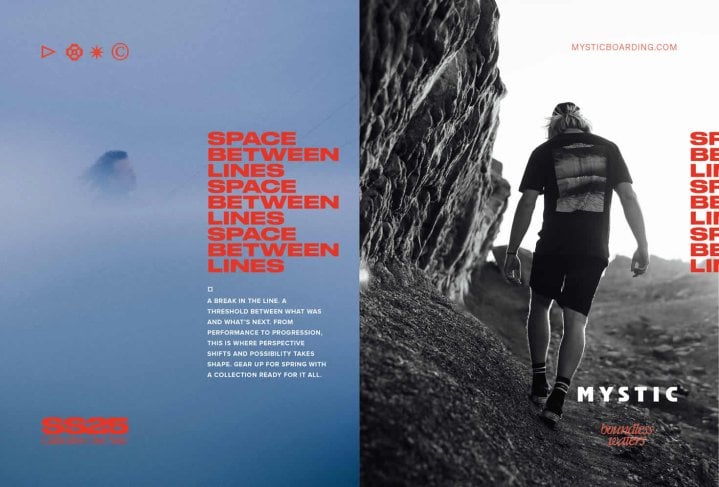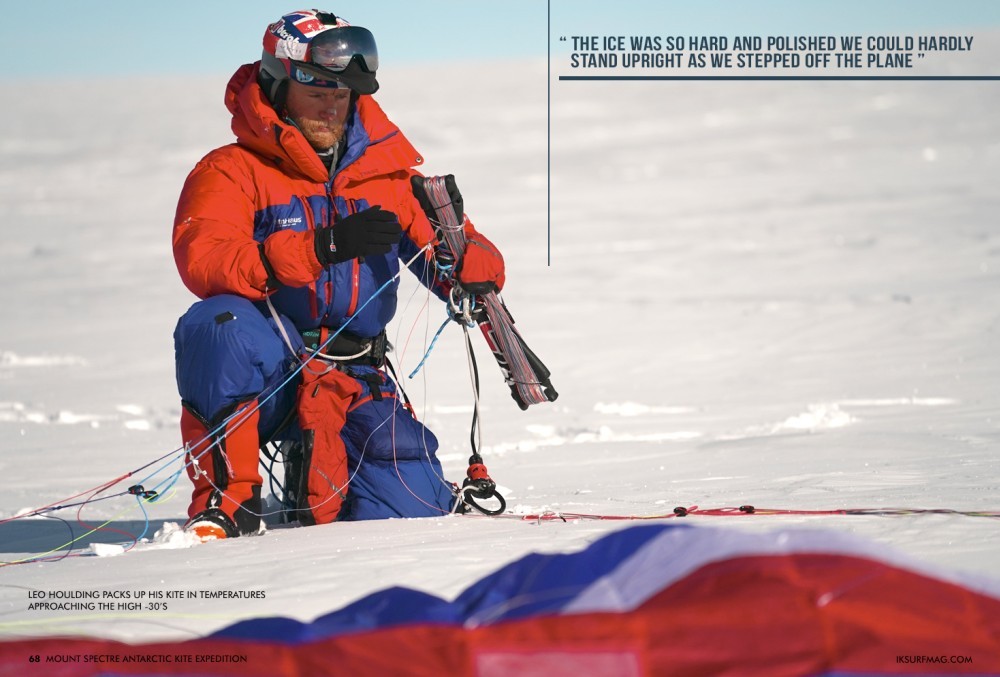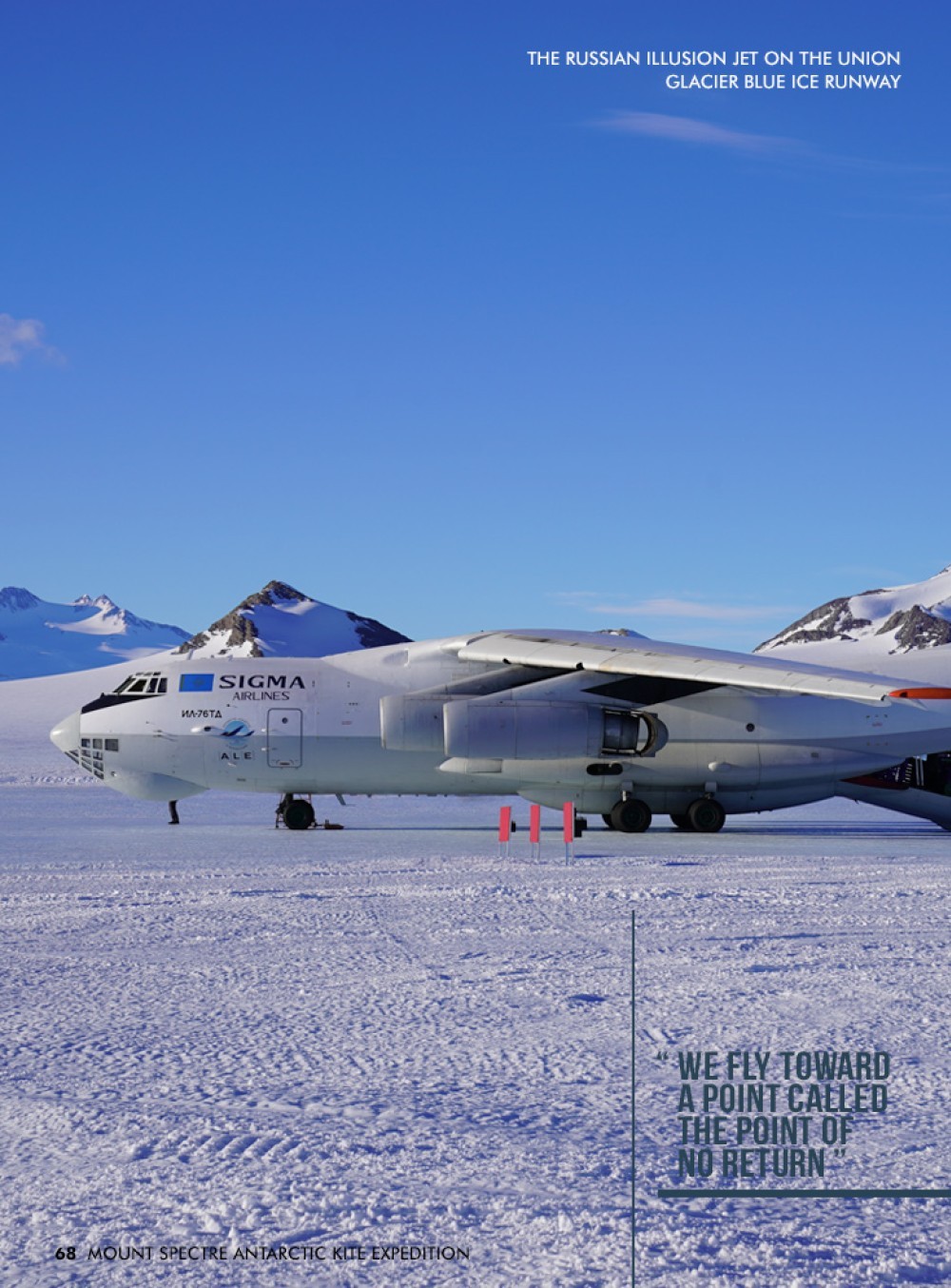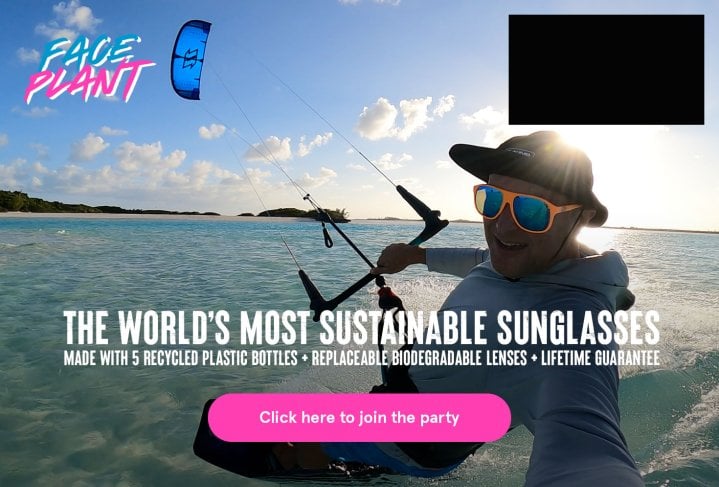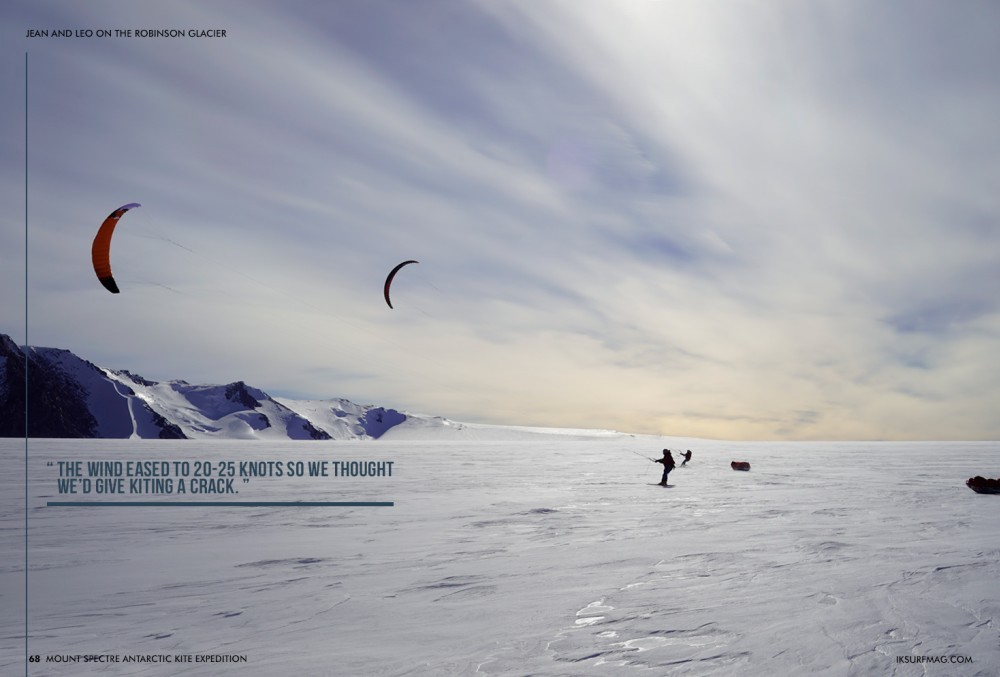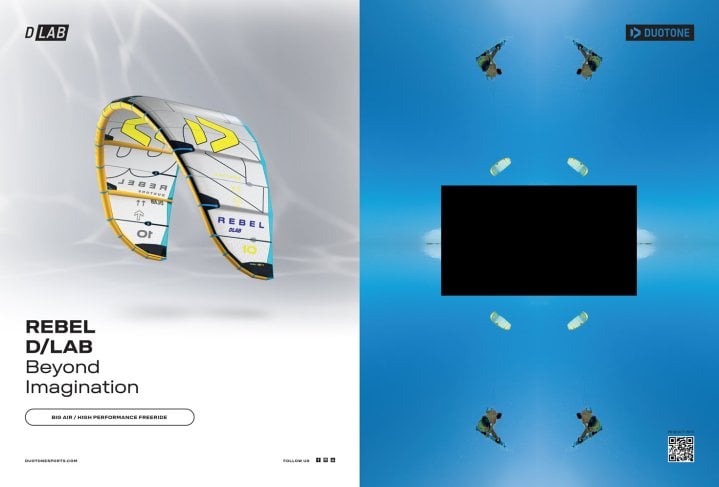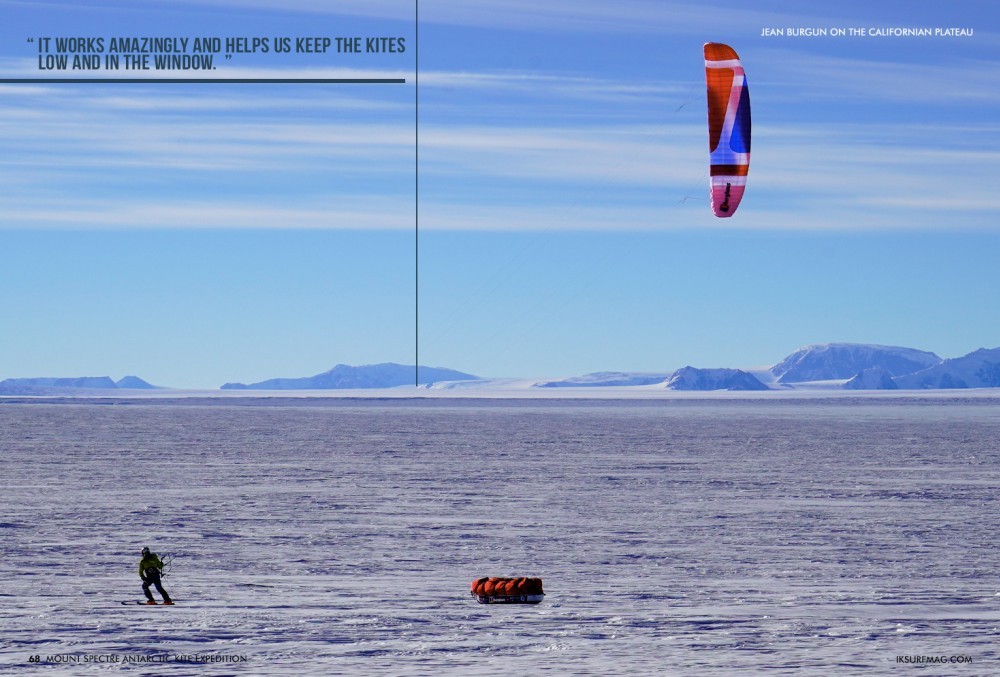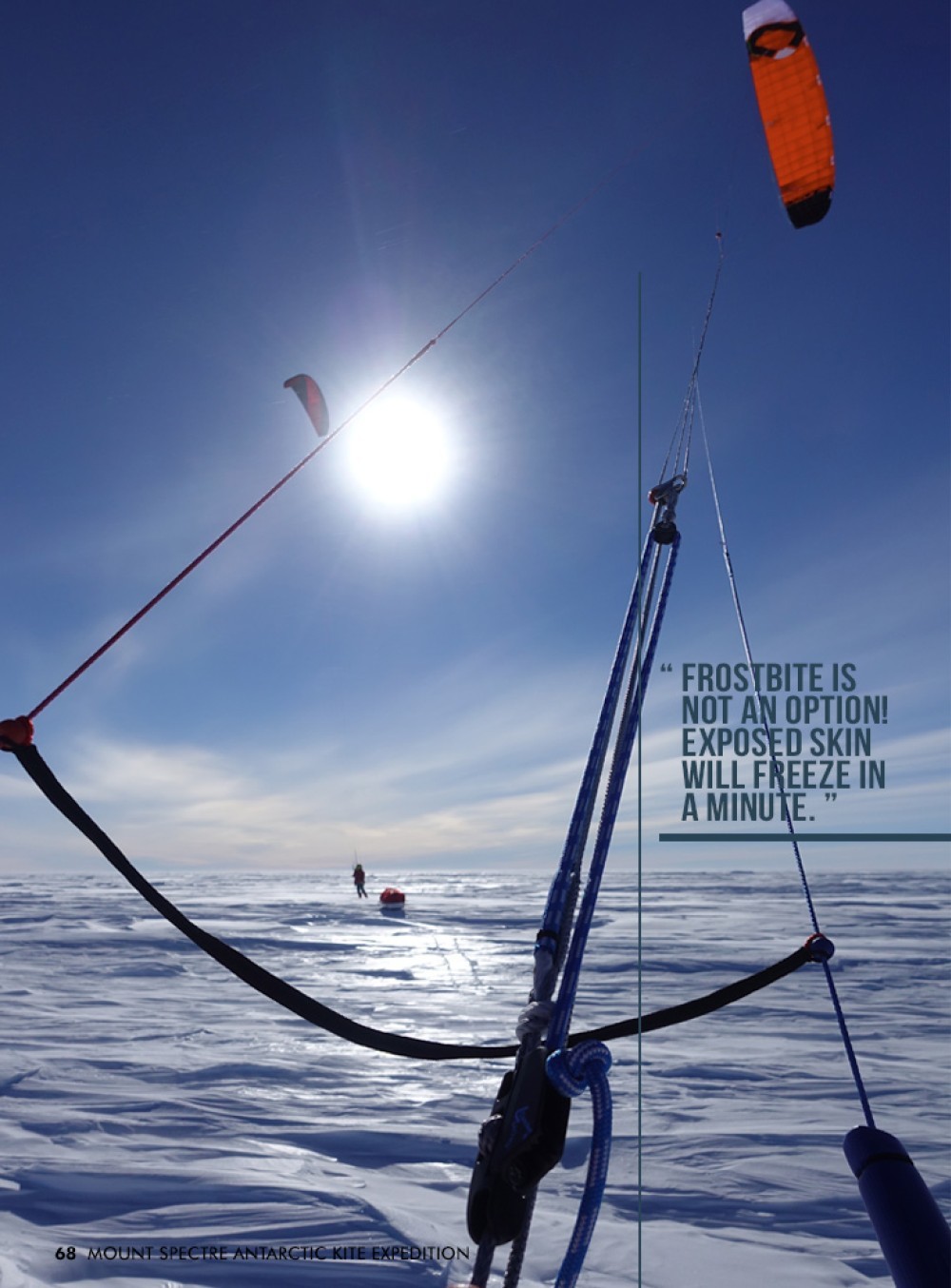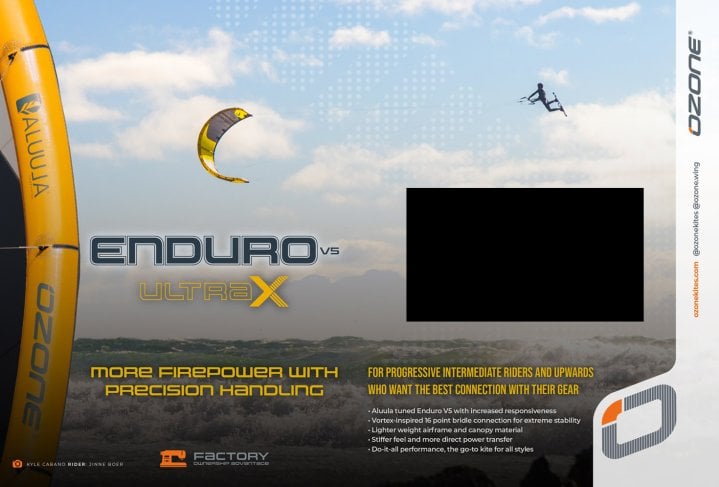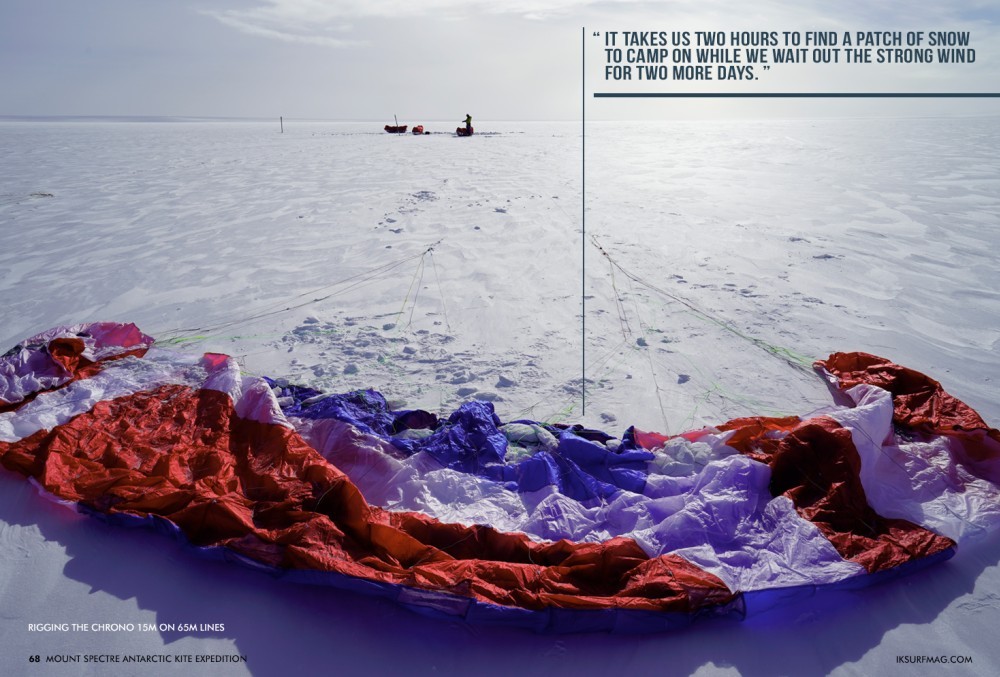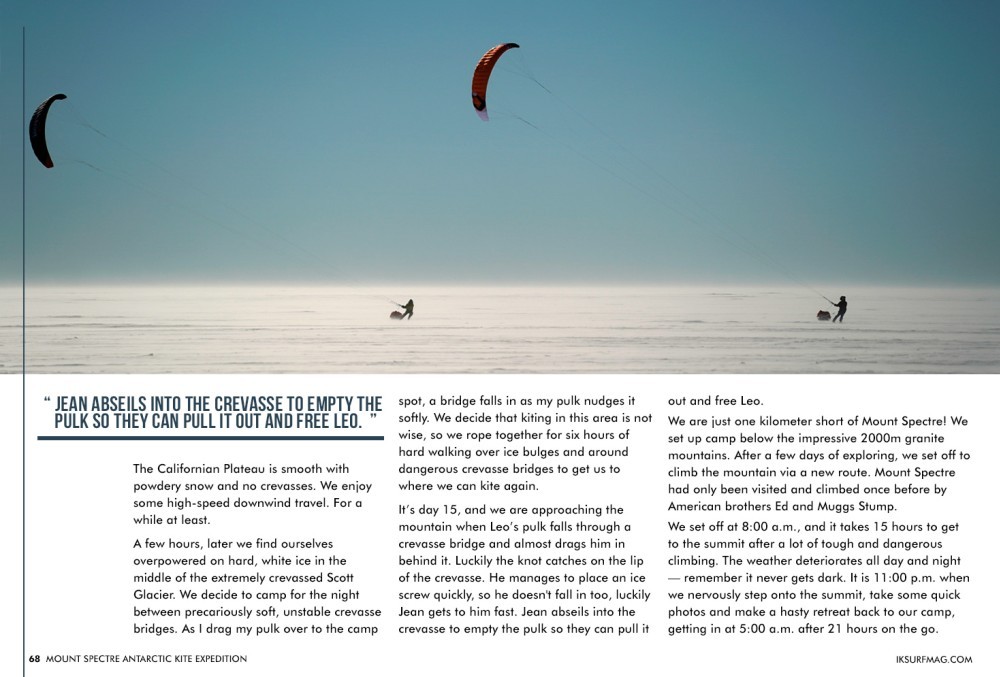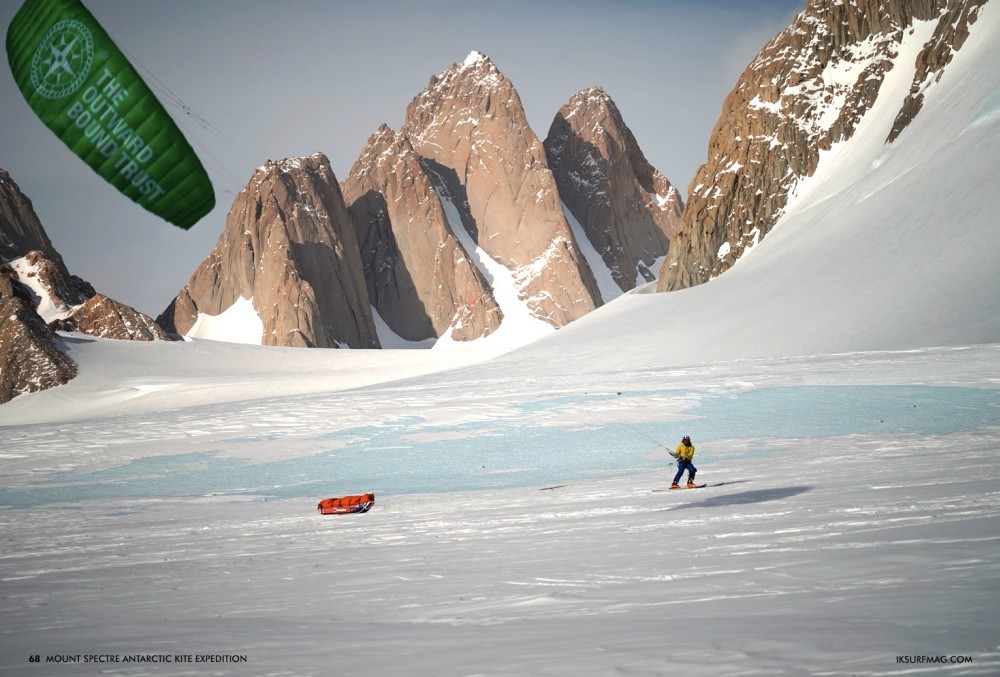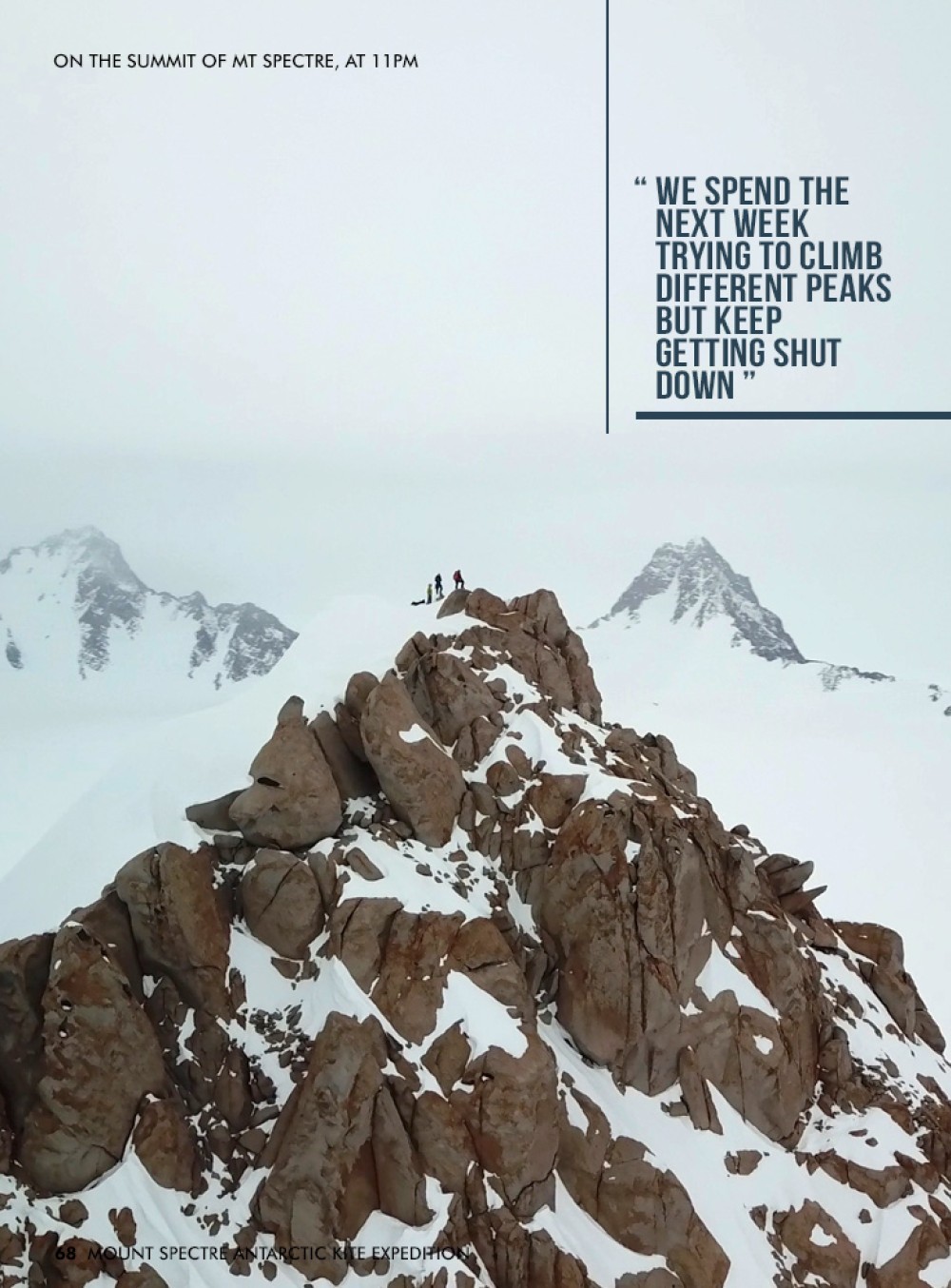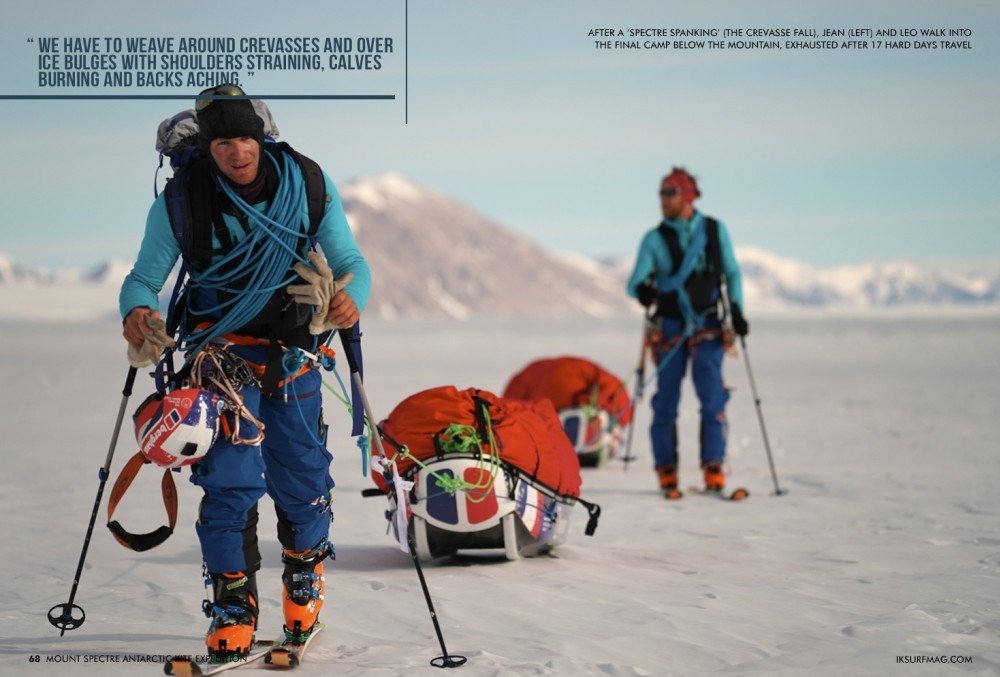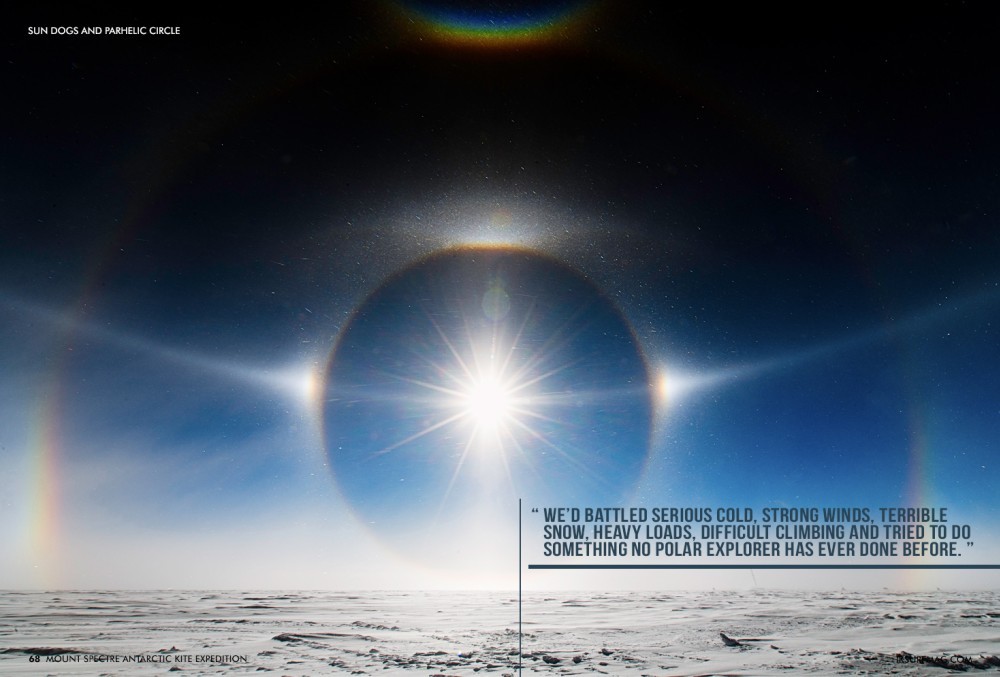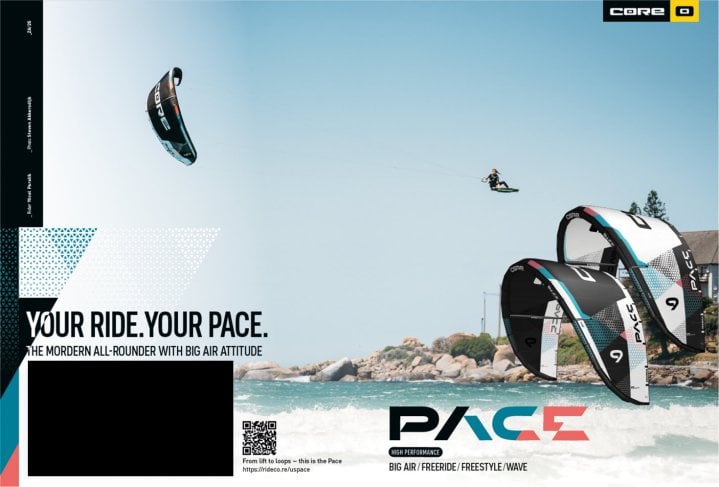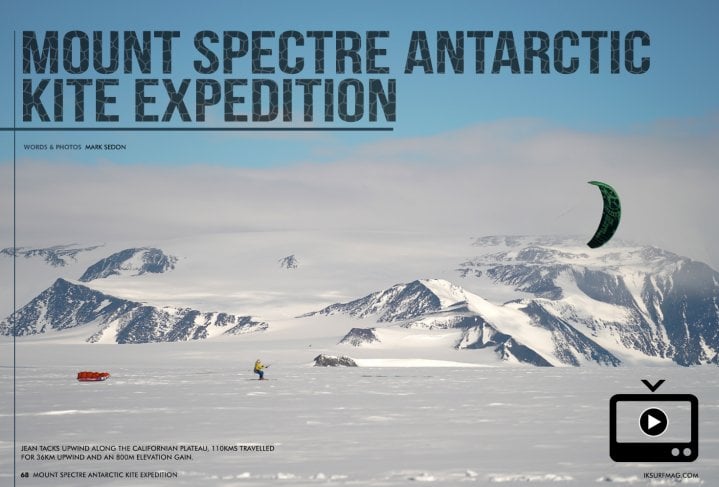
Kitesurf Antarctica: Mount Spectre
Issue 68 / Tue 10th Apr, 2018
Leo Houlding, Jean Burgon and Mark Sedon find themselves the adventure of a lifetime, a ten-week, 1,700-kilometre kite, ski and man-hauling expedition to climb one of the most remote mountains on earth, Mount Spectre in Antarctica. Read the incredible story right here...
Exploration is changing, in the 21st century explorers are turning to wind power more and more and the advantages of crossing vast snow and icescapes with kites are clear. Can you imagine spending 50 days in Antarctica though struggling to survive everyday, dealing with glaciers, crevasses and freezing storms? Fortunately Mark Sedon has done the hard work for us and shares his incredible experiences here…
I heard the crackle on the radio. It was a panic-stricken voice, the call we’d been dreading since landing at 3,000m, just 200km from the South Pole. Leo was saying, “my pulk has fallen in a crevasse and is pulling me toward it. Help!” A pulk is a type of sled, and ours were full of climbing gear, kites, camping gear and food for 70 days in Antarctica, weighing in at nearly 200 kilograms each. This was bad.
A little over two weeks prior, we’d flown from Chile to Antarctica in a chartered Russian Illusion jet, landing on the commercial blue ice runway called Union Glacier operated by US company Antarctica Logistics & Expeditions. The ice was so hard and polished we could hardly stand upright as we stepped off the plane into the fresh -15 degrees Celsius air. After a few days of sorting food and re-packing gear, we boarded the Twin Otter aircraft for a flight that would take us closer toward our goal, Mount Spectre. This wasn’t to be your average kite trip it cost an eye-watering $350,000, with another pre-paid rescue bond of $100,000, which world-famous UK climber Leo Houlding had raised through his sponsors and supporters.
Leo, French kiter Jean Burgon and I discovered the adventure of a lifetime— a ten week, 1,700-kilometre kite, ski and man-hauling expedition to climb one of the most remote mountains on earth, Mount Spectre. If we had another $100,000, we could have flown to the mountain, but we didn’t, so we used kites to travel the distance.
We take off from Union Glacier and fly four hours to what may be the most remote gas station in the world, Thule Corner, which consists of several barrels of aviation fuel buried in the snow. As the pilot bashes the fuel cap on a barrel with a large crescent wrench, he remarks in a thick Canadian accent, “nothing is easy down here.” At that point, we had no idea that we’d be repeating that phrase daily.
With a full tank of gas, we fly toward a point called the point of no return, when a pilot flies as far as possible using just under half a tank of the fuel before turning around and heading back to start.
We land on the hard, bumpy snow, 200 km from the South Pole on November 20, 2017. As we step from the plane, the cold hit us like a smack in the face, and we almost turn and get back on board. It’s -35 degrees Celsius, and there’s 10-15-knots of wind.
We unload the plane, the pilots wave us goodbye and fly back to the comforts of Union Glacier. As we set up the tent in the bitter cold, I notice some clouds on the horizon and say to the others, “looks like a storm brewing”. They look at me as if I am nuts. We are all blown away by the beauty and serenity of the Polar Plateau but quickly end up inside our tents brewing up dinner and talking about the trip ahead.
I wake during the night when 40-knot gusts hit our tent, and I can hear driving snow. It’s weird considering that the Polar Plateau is a desert and it hardly ever snows here. But, this was a real storm, and after breakfast, we go outside to check on the tent and gear while shooting some photos and film for the movie we are making of our trip. Filming with down mittens on in temperatures (including wind chill) approaching -60 degrees Celsius is not much fun, but oddly we enjoy it and manage to keep our spirits up with jokes and good banter as the storm rages on for four days.
On day five the clouds part and the wind eased to 20-25 knots so we thought we’d give kiting a crack. In the bitter cold, we rig up our 9m Ozone Hyperlink kites. We know that we’ll be overpowered, but it is the smallest we have. With the heavy pulks we also need extra power to move, and we have 8m traces on so if we crash the pulk will hopefully stop, or at least slow down before running us over like a speed bump. I also suggest we tie knots in the rope, a standard glacier travel technique so that if a pulk falls in a crevasse, the knot should catch in the snow and not pull us in with it.
Jean launches first while I film. He gets hoisted 3 or 4 meters off the ground, then gets the kite under control and heads off. Leo is next and gets lifted even higher before gaining control. Later, Jean suggests that we move the knot on the de-power further down on the race bars we are using which allows us to hold the bar in while launching, overpowering the kite, so it doesn’t pull too hard while we slowly move it to the side of the window for a more controlled start. It works amazingly and helps us keep the kites low and in the window.
On the first day, we kite for 3-4 hours, moving quickly over the rough snow and wood-like sastrugi. The sastrugi are formed by years of wind etching and will flip the pulk on its side if we go too fast or hit it at an angle. If our pulk flips, we have to try and sidestep or kite back to the pulk, which isn’t easy when fully overpowered.
Our systems aren’t dialled in that first day. After a while, my goggles freeze up, reducing my vision to a blurry haze. I call on the radio that I have to stop, and I eject my kite. Unfortunately, the others are in the same position, and we end up 500 meters apart. It takes us an hour to drag each pulk, one at a time, into camp. But we are stoked to be moving after the four-day welcome storm.
From then on, we move as much as we can each day. The wind is strong. We’d been told about, and were expecting, polar high-pressure systems that give clear skies and 10-12 knots, but we are battling 20+ knots and stormy skies. We wear 8000m down suits and, despite wearing ski boots, three sizes too large with exceptionally warm liners and a neoprene over-boot, our feet often get cold. Numb feet are always a concern. One morning, I end up with Jean’s bare feet on my stomach for 30 minutes to re-warm them. Frostbite is not an option! Exposed skin will freeze in a minute. When we remove our goggles, we feel the liquid in our eyes freezing between blinks.
It was about day eight when things really spiced up. We are kiting down from the Polar Plateau when the terrain in front of us drops out of sight. The surface turns to a solid, concrete-like blue ice with car-sized bulges and car-swallowing crevasses. I am a mountain guide, and this is my tenth expedition to Antarctica, so I have an idea of what’s ahead.
I call Leo on the radio and tell him I think we must be off route. This looks like an icefall. The wind is strong, over 25 knots, and we can’t stop. The kites lift us off the ground if we put them above us. He replies that the GPS route we have is pointing us this way, so we carry on. I am last and come over a bulge to see Leo’s pulk upturned, and below him, the trace stuck around an ice bulge. Jean is trying to get to Leo’s pulk to tip it back upright. However, his kite and pulk are also downwind and downhill of him, trying to drag him down the icefall.
There is nothing more to do except eject our kites, roll them up and ski our pulks down the icefall. The ice is hard and loud. The pulks still threaten to drag us down, so it was with some difficulty that we ski them down. Below the icefall we are faced with blue ice again, it takes us two hours to find a patch of snow to camp on while we wait out the strong wind for two more days. Luckily for us, we’d dropped 1,500m and the temperature has risen to -20 C without the wind, which seems quite reasonable!
When the wind drops two days later, we cautiously launch our small kites and have our first enjoyable kite of the trip. Remember, we are ten days in. The Californian Plateau is smooth with powdery snow and no crevasses. We enjoy some high-speed downwind travel. For a while at least.
A few hours, later we find ourselves overpowered on hard, white ice in the middle of the extremely crevassed Scott Glacier. We decide to camp for the night between precariously soft, unstable crevasse bridges. As I drag my pulk over to the camp spot, a bridge falls in as my pulk nudges it softly. We decide that kiting in this area is not wise, so we rope together for six hours of hard walking over ice bulges and around dangerous crevasse bridges to get us to where we can kite again.
It’s day 15, and we are approaching the mountain when Leo’s pulk falls through a crevasse bridge and almost drags him in behind it. Luckily the knot catches on the lip of the crevasse. He manages to place an ice screw quickly, so he doesn't fall in too, luckily Jean gets to him fast. Jean abseils into the crevasse to empty the pulk so they can pull it out and free Leo.
We are just one kilometer short of Mount Spectre! We set up camp below the impressive 2000m granite mountains. After a few days of exploring, we set off to climb the mountain via a new route. Mount Spectre had only been visited and climbed once before by American brothers Ed and Muggs Stump.
We set off at 8:00 a.m., and it takes 15 hours to get to the summit after a lot of tough and dangerous climbing. The weather deteriorates all day and night — remember it never gets dark. It is 11:00 p.m. when we nervously step onto the summit, take some quick photos and make a hasty retreat back to our camp, getting in at 5:00 a.m. after 21 hours on the go. Within 30 minutes, the storm arrives and strong winds buffet our tents. Getting stuck on the mountain in high winds would have required an epic survival effort.
We spend the next week trying to climb different peaks but keep getting shut down due to severe wind and unsettled weather. We are surrounded by unclimbed mountains but only manage to get up one more summit before our time is up, and we have to set off for our 1,400-kilometer journey back to Union Glacier to catch our flight home.
The next part of our trip is 20 days of ‘man-hauling’ back up the Scott Glacier. Man-hauling is dragging the pulks in 50-minute sessions with 10-minute breaks. It’s hour after hour of tiresome, monotonous work, and most polar explorers do it week after week. Due to the extremely crevassed nature of the Scott Glacier, we have to weave around crevasses and over ice bulges with shoulders straining, calves burning and backs aching. In one 10-hour day, we only travelled 12 kilometres!
Finally, on the fifth day of man-hauling, the surface cleans up, the crevasses thin out and we launch our 15m Ozone Chrono kites on 65m lines. We do 110 kilometres of tacking and make it 36 kilometres upwind, toward home. It is hard work, but we cover more than twice the distance of what we could walk in a day.
From that day on, we rest when there is no wind and kite when there is. One hundred kilometre days become the norm. It all depended on the always-changing surface condition. We find hard blue glacier ice; rough wind etched sastrugi, soft powder, hard white ice or a combination of all of them.
We cover 201 kilometres one day and manage over 650 kilometres in a 4-day stint. It is really hard on the body, but once or twice a week, the wind lets up, and we sit around and eat, drink a whiskey/rum tea or take in the incredible scenery.
One particular rest day, we witness one of the most amazing natural phenomena I have ever seen. It is like a mixture of a double sundog, 22° halo (the arcs passing through each sundog), a sun pillar (the vertical line) and a parhelic circle (the horizontal line). Numerous rainbows circle the sun and extend horizontally around the entire sky. It feels like we are in a science fiction movie. To top that off, the wind comes up at 10 p.m. just when we get into our sleeping bags, so we pack up camp and kite through the night, covering over 100 kilometres.
After 50 days in the field, we are on our last day, kiting through the Horseshoe Valley with mountains all around us and smooth powder snow under our skis, moving silently at 35-40 kilometres/hour. We cross over a high col, ejected our kites in strong winds and ski down to just below Union Glacier. Only 5 kilometres from camp, we clip our pulks to our harnesses, put on touring skins and walk back into camp just in time for the buffet dinner we’d been dreaming about.
It’s a good time to wind down and reflect. We’d been tested in every way. Not one of the 50 days had been easy. We’d battled serious cold, strong winds, terrible snow, heavy loads, difficult climbing and tried to do something no polar explorer has ever done before. We’d pulled it off, and I loved every minute of it. Best of all, the three of us became and remained best of friends along the way, laughing and enjoying the trip as a team.
Videos
By Mark Sedon


